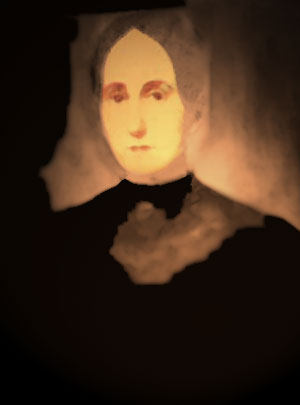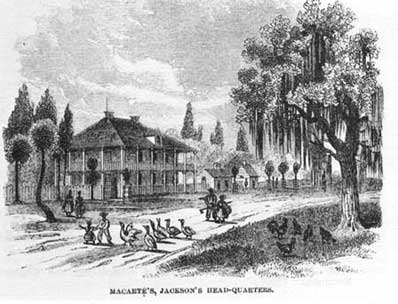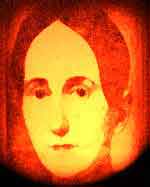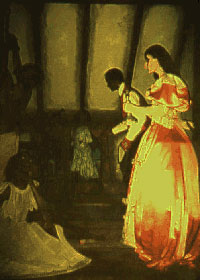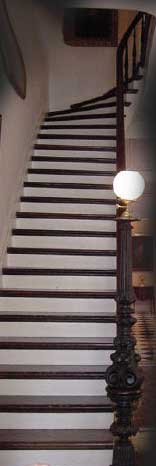Warning: include(): http:// wrapper is disabled in the server configuration by allow_url_include=0 in /home/nolahauntsu/public_html/phpmenu/side_menu.php on line 1
Warning: include(http://www.bachigraphics.com/saintisadore/index.php): failed to open stream: no suitable wrapper could be found in /home/nolahauntsu/public_html/phpmenu/side_menu.php on line 1
Warning: include(): Failed opening 'http://www.bachigraphics.com/saintisadore/index.php' for inclusion (include_path='.:/usr/lib/php:/usr/local/lib/php') in /home/nolahauntsu/public_html/phpmenu/side_menu.php on line 1
|
A
TALE OF TWO TALES:
THE
TRUTH ABOUT MADAME LALAURIE?
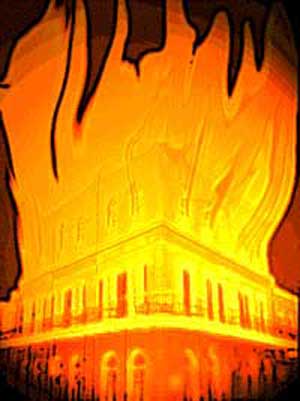
|
Madame
Delphine LaLaurie |
Story: A. Pustanio / Photos: Hershel Meyers
Art by Ricardo Pustanio |
Was
it really a crucible of horror that Madame
Lalaurie fled that
April
day in 1834, or was she the
“first
victim of yellow journalism” in America?
Marie Delphine Maccarty
Lalaurie
She
was born Marie Delphine, daughter of Louis
Barthelemy Chevalier de Maccarthy. She was
first married on June 11, 1800 to Don Ramon
de Lopez y Angulo. When he died on March
26, 1804 in Havana, Cuba, she married Jean
Blanque in 1808, who died in 1816. From
there she married Dr. Lalaurie on June 12,
1825
It may be
that the facts present a much different story
than what has been handed down in legend.
You be the
judge!
THE FACTS ABOUT THE LALAURIE
LEGACY
The following is excerpted
in its entirety from Old New Orleans:
Walking Tours of the French Quarter,
by Stanley Clisby Arthur, © 1990 by Pelican
Publishing Company, Gretna, Louisiana, @ pages
96-99:
" 'THE HAUNTED HOUSE’
1140 Royal Street
The three-storey building at the southeast
corner of Royal and Governor Nicholls street,
to some the most famous private residence
in old New Orleans, gained its eerie title,
‘The Haunted House,’ from an
oft-repeated tale in which spirits of tortured
slaves clank their chains during the midnight
hours in remembrance of awful punishment
meted out to them by their mistress –
a high-bred lady of old New Orleans who
had been charged with finding an uncanny
delight in dealing inhumanly with her slaves.
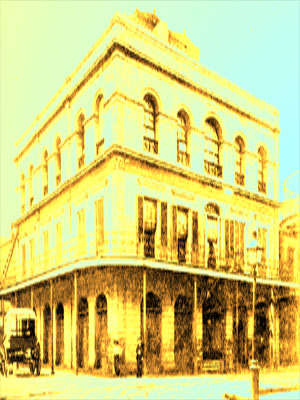
As the flames grew larger
and hotter, word of the fire spread through
the streets and soon the house was thronged
with people over to assist Mme. Lalaurie
in saving her valuables. There were among
the crowd citizens of high standing, many
of whom bore eyewitness to the scenes that
followed. The fire was gaining rapidly,
the kitchen was in flames and the upper
stories were filled with smoke. Mme. Lalaurie
seemed only interested in retrieving her
plates, jewels and robes before they were
burnt to a crisp.
Like all such tales, the story has grown
in ferocity through its countless retellings
and the probabilities are that even the
original story of over a century ago was
a gross exaggeration. It now appears that
the mistress of this home was the first
victim of yellow journalism in this country
and that she was far from being the ‘fiend’
tradition has labeled, or should we say,
libeled her. The facts of this ‘strange
true story’ are as follows:
The traditional tales of the Vieux Carre
have it that this house was built in 1780
by two brothers, Jean and Henri de Remarie,
and that such guests as Marshal Michel Ney,
Napoleon’s famous commander; the duc
d’Orleans, later, Louis Philippe,
king of France; and the Marquis de Lafayette
have slept in this mansion. But we are compelled
to make the pertinent observations that
Marshal Ney never came to Louisiana, that
Louis Philippe was here in 1798, and that
Lafayette visited New Orleans in 1825 –
yet the ‘Haunted House’ was
not built until 1832!
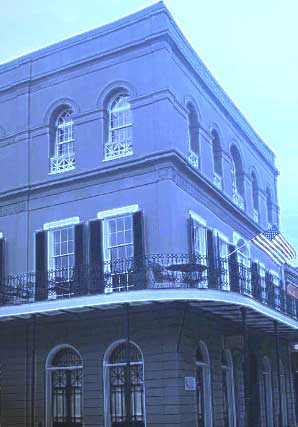
As for the home on Royal
Street, it was restored and renovated many
times over the intervening years, passing
through the hands of many a land-loaded
New Orleanian.
There are those who denounce historical
accuracy when it destroys fallacious tradition
… those who claim that a good story
must never be sacrificed and crucified on
the cross of truth. Much as one admires
the colorful tradition of old New Orleans,
our mission is to give a factual history
of the landmarks of the Vieux Carre. So,
to stick to fact, we must point out that
the lots upon which the ‘Haunted House’
stands were purchased by Mme Louis Lalaurie,
September 12, 1831, from Edmond Soniat du
Fossat, and the house then built was not
ready for occupancy until the spring of
1832. As it was part of the tract given
the Ursuline nuns, this was the first, and
only, house built on this particular site.
Mme Lalaurie was one of
five children born to Louis Barthelemy Chevalier
de Macarty and Marie Jeanne Lovable, two who
stood high in the social life of old New Orleans.
One of their daughters was christened Marie
Delphine Macarty. She first married, on June
11, 1800, Don Ramon de Lopez y Angula, the
ceremony being performed at the St. Louis
Cathedral by Luis de Penalver y Cardenas,
the first bishop of the diocese of Louisiana,
and the marriage certificate was signed by
the celebrated Fray Antonio de Sedella. The
husband was described in this document as
Caballero de la Royal de Carlos, Intendent
of the Provinces, a native of the community
of Regno,Galicia, Spain, and the legitimate
son of his Lordship Don Jose Antonio de Lopez
y Angula and Dona Ana Fernande de Angule,
daughter of Dona Francisca Borja Endecis.
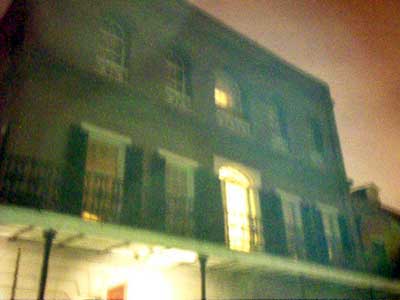
Laularie house is known
as the No.# 1 Most haunted house in the
New Orleans French Quarter
Shortly after the Louisiana Purchase, on
March 26, 1804, Delphine Macarty’s
husband was recalled to the court of Spain,
the letter carrying this royal command stating
that the young Spanish officer was ‘to
take his place at court as befitting his
new position.’ At this time Don Ramon
was consul general for Spain in this new
American territory. While in Havana, en
route to Madrid, Don Ramon suddenly died
and a few days later his daughter was born
in the Cuban city. This infant was baptized
Marie Delphine Borja Lopez y Angula de Candelaria,
but she became best known in later years
as ‘Borquita,’ meaning ‘little
Borja,’ from the fact that she was
named after her father’s grandmother.
Left a widow, Delphine Macarty and her
baby daughter returned to New Orleans. Four
years later, in 1808, she again married,
choosing for her husband a prominent banker,
merchant, lawyer, and legislator named Jean
Blanque, a native of Bearn who had come
to Louisiana with Prefect Laussat in 1803.
At the time of his marriage, June 16, 1808,
Blanque purchased the residence at 409 Royal
Street and in this home Delphine became
the mother of four other children: Marie
Louise Pauline, Louise Marie Laure, Marie
Louise Jeanne, and Jean Pierre Paulin Blanque.
In that stylish Royal Street home or in
the ‘Villa Blanque,’ a charming
country place fronting the Mississippi River
just below the city limits, Delphine Macarty
Blanque divided her time, both places frequented
by the socially elect.
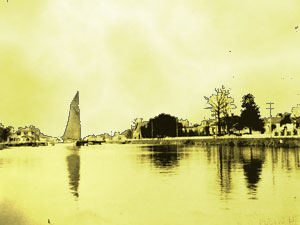
It
is said Madame LaLaurie stopped and took
refuge at the Pilot House (still standing)
located on the shores of Bayou St. John,
and that later she boarded a merchant schooner
and escaped under cover of darkness.
Jean Blanque died in 1816,
and Delphine Macarty remained a widow until
June 12, 1825, when she again married. Her
third husband was Dr. Leonard Louis Nicolas
Lalaurie, a native of Villeneuse-sur-Lot,
France, who came to New Orleans to establish
a practice. Borquita, the daughter by her
mother’s first marriage, became the
wife of Placide Forstall, member of a distinguished
Louisiana family, and Jeanne Blanque married
Charles Auguste de Lassus, only child of Don
Carle de Lassus, former governor of Upper
Louisiana, and later governor of the Baton
Rouge post of West Florida when they were
under Spanish rule.
The Lalaurie mansion was
erected in 1832 and for the next two years
was the scene of many fashionable affairs,
for the Lalauries entertained on an elaborate
plan. On the afternoon of April 10, 1834,
an aged cook set fire to the house during
the absence of her mistress. When neighbors
rushed into the mansion to fight the fire
and try to save the furniture and other valuables,
slaves were found chained in their quarters.
Although the fire was extinguished, the indignation
of those who found the helpless slaves blazed
high and a newspaper editor, Jerome Bayon
of the Bee, published a heated account of
the happening and quoted those who had investigated
the Lalaurie slave quarters. This newspaper
account roused public indignation to such
a pitch that on April 15 a mob, led by irresponsibles,
charged the house and began to wreck it. The
rowdies were finally dispersed by a company
of United States regulars who had been called
out by a helpless sheriff.
During the excitement Madame
Lalaurie and her husband took to their carriage
and, with their faithful Creole black coachman
Bastien on the box, swept through the howling,
cursing rabble and, with the horses lashed
to a the full gallop, made her way out of
the city. It is supposed the carriage reached
Bayou St. John where a lake craft was secured,
for on April 21, 1834, the Lalauries were
in Mandeville, across Lake Pontchartrain,
at the home of Louis Coquillon. There Madame
Lalaurie signed a power-of-attorney placing
her son-in-law Placide Forstall in charge
of her affairs, while her husband signed a
similar document in favor of his wife’s
other son-in-law, Auguste de Lassus. From
Mandeville the Lalauries made their way to
Mobile, where a ship took them to France.
Neither Delphine nor her
husband ever returned to New Orleans. She
remained in Paris, living there honored and
respected in spite of the lurid tales that
lived after her in New Orleans. Following
her death on December 7, 1842, her body was
secretly returned to New Orleans and buried
in St. Louis No. 1 Cemetery.
The Lalaurie mansion was
sold to various owners but the tale that it
was ‘haunted’ and the midnight
rendezvous for ghosts grew in the telling
as only such stories can grow. The principal
‘ghost’ is, according to the most
frequently quoted tale, that of a little girl
slave who, to escape the whip of her mistress,
climbed to the roof and jumped to her death
into the courtyard below. Another tale, equally
untrue, was that the mistress of the mansion
buried all her victims in the courtyard well.
The general impression that the place was
haunted was sufficient to keep superstitious
blacks from passing the house after nightfall.
In the days of Reconstruction following
the Civil War, the old Lalaurie mansion
became the Lower Girls’ School. During
the government of the carpetbaggers, whites
and blacks were taught in the same rooms
until the formation of ‘The White
League’ in 1874, when the white element
marched on the house and expelled the black
pupils. In the 1880’s the mansion
became a conservatory of music. No matter
who has lived in it since, or the manner
of business that was carried on in the ground-floor
stores, the name ‘haunted’ has
clung to it in spite of the testimony of
those inhabiting the place that ghosts have
never disturbed their slumbers.
Tradition has it that the
handsome entrance door ‘was hammered
out of iron by the slaves Madame Lalaurie
kept shackled to the anvil.’ This must
be taken with several generous pinches of
salt, for the doors is not of iron but wood
and the decorations on it were not cared but
put on by appliqué, a sort of plastic
wood applied and formed as a sculptor would
lay on modeling clay. These ornamentations
show, in the lower oblong panel, Phoebus in
his chariot, lashing his griffins. Scattered
over the door are urns, flowers, trumpet-blowing
angels, a beribboned lyre, an American eagle
bearing on its breast the shield of the Union,
leaves, scrolls, and whatnots – a marvelous
example of some unknown craftsman’s
art. To save the door from the knives of souvenir-hunters,
one owner painted it a dingy brown-black.
accounts of the Lalaurie episode. My
account, differing in many respects from
those of these earlier writers, is based
on recently found documents, notarial acts,
and family documents.”
This story originally appeared
in The Times-Picayune on Jan. 28, 1941. It
is reprinted in its entirety.
Epitaph-Plate of 'Haunted' House Owner Found
Here
Marble Cutter's Discovery Starts New Talk
of Madame Lalaurie
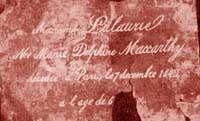
Legends of New Orleans'
famed "haunted house" at 1140 Royal
Street, which since 1873 has served as a refuge
for homeless men and boys, were revived Monday
with the announcement of the "discovery"
of an epitaph-plate of one of the former owners
of the residence.
Corroded and cracked by time, the copper plate
bore the inscription: "Madame Lalaurie,
nee Marie Delphine Macarty, decedee a Paris,
le' 7 decembre, 1842, a l'age de 6 --. "
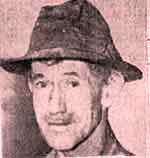
Eugene
Backes
The plate was discovered by
Eugene Backes, 53-year-old marble cutter,
four or five years ago in the No. 4 alley
of St. Louis cemetery No. 1, where he served
as sexton from March, 1923 to January, 1924.
Backes, who is engaged in polishing, grinding
and cutting stones at his little shop at
807 St. Peter Street, decided to delve into
the conflicting history of the "haunted
house," which is now known as the Warrington
House, and of Madame Lalaurie, its early
mistress.
Historians are in conflict over the story
of Madame Lalaurie and her once-imposing
residence at 1140 Royal Street, but, they
are agreed that she fled the mansion on
April 10, 1834, after a fire swept the building
and led neighbors to discoveries in the
slave quarters.
Newspapers of the day pictured, rightly
or not, the Lalaurie slaves, chained in
the cubby-holes as tortured and half-starved
creatures... Newspapers reported that she
and her husband went by carriage to Lake
Pontchartrain, boarded a sloop at Bayou
St. John, deposited gold with the captain,
and sailed for ....
There is disagreement whether Madame Lalaurie
sailed for France from Mobile or New York;
and another school of thought maintains
that Madame Lalaurie never left New Orleans,
that she died and was buried here.
They are agreed, however, that she was
born Marie Delphine, daughter of Louis Barthelemy
Chevalier de Maccarthy, whose name was later
simplified to Macarty, and then on June
11, 1800, she was married to Don Ramon de
Lopez y Angulo. Her first husband died on
March 26, 1804, at Havana, Cuba, and she
married in 1808 to Jean Blanque, who died
in 1816. Madame Lopez-Blanque on June 12,
1825, became the wife of Dr. Leonard Louis
Lalaurie.
Stanley Arthur, president of the board
of curators of the Louisiana State Museum,
is staunch in his support of Madame Lalaurie.
"I have always thought,"
he said, "that Madame Lalaurie was the
first victim of yellow journalism. There is
nothing in the record to indicate that she
was the type of a woman pictured by them.
One must remember that there was much social
jealousy in those days, and that Madame Lalaurie
occupied an enviable position socially."
He revealed that he had found a record
of Madame Lalaurie granting permission for
the emancipation of a slave in the early
1830s, which contradicts the tales of her
cruelty.
MACARTY PLANTATION
Adjacent to and below the Duralde tract
of land, between modem Independence and
Alvar streets, stood the property of Louis
Chevalier Macarty, acquired in 1794. Inherited
by Louis Barthelemy Macarty and his sister
Marie Delphine Macarty, the residence and
its formal gardens are depicted on the Zimpel
Map of 1833.
Marie Delphine Macarty became the subject
of perhaps more folklore and legend than
any woman of her day. The townhouse of her
husband, Dr. Leonard Lalaurie, at 1140 Royal
St., became the site of her alleged brutal
mistreatment of slaves which led to her
flight from the city. She ranks with Marie
Laveau as one of the most notorious figures
in nineteenth century New Orleans.
For her brother, between 1838 and 1841,
the alignment of Good Children (now St.
Claude) Avenue, and similarly, Greatmen
(now Dauphine) Street had apparently been
opened across the Macarty tract. Macarty
retained three large unsubdivided tracts,
bounded above by a line bisecting the squares
between modem Independence and Pauline streets,
and bounded below by a line bisecting the
squares between modem Alvar and Bartholomew
streets, as shown on the Pinistri map (1841).
Following Macarty's death
in 1846, the plantation was acquired by wealthy
philanthropist John McDonogh. Shortly thereafter,
McDonogh died leaving his property in equal
shares to the cities of New Orleans and Baltimore
to be used expressly for the purposes of public
education. His will was contested and finally
resolved in 1858-59 when the city took possession
of the plantation, dividing it into 795 lots
sold at public auction. However, by resolution
of the City Council, the mansion was reserved
for public education and the gardens surrounding
it became Macarty Square.
MACARTY SQUARE
For nearly ninety years after, Macarty Square
was the neighborhood gathering spot. A much
reduced open green space is now what remains
of what was once the largest and shadiest
public square in the city is a story of
progress, of compromise and politics that
lead to the eventual demise of the city's
most splendid neighborhood park.
In the early 1900s, Macarty Square was
the hub of leisure activities for the 100-square
block neighborhood in the Ninth Ward now
known as Bywater. Two blocks long from Burgundy
Street to St. Claude Avenue, and one block
wide between Alvar and Pauline Streets,
the square was dotted with young oak trees,
benches and urns. It represented the ideal
of a new community only twenty blocks from
the French Quarter. Sixteen sidewalks radiated
from two central spots in the square. On
sunny afternoons the grounds were festive;
the setting was lush and beautiful, much
like the beginnings from whence it came.
Several fine homes were built
around the square. Among them are the Frey
Mansion, once owned by the L.A. Frey Meatpacking
family, and a former Schwegmann family residence.
The square nurtured the sense of neighborhood
shared by the citizens of the Ninth Ward.
In 1947, the New Orleans city government was
looking for land on which to build a new City
Hall. In a bizarre twist of McDonogh's philanthropy,
the city quietly swapped Macarty Square for
property owned by the School Board on Perdido
St. where City Hall now stands. Upon Macarty
Square, the Francis T. Nicholls School gymnasium
and athletic field were built.
Macarty Square behind the Frederick Douglass
High School was once a part of a large plantation
owned by Louis Barthelemy Macarty. His prominent
Irish-French ancestors had moved to Louisiana
around 1830, and one of them had been mayor
of the city. Another Macarty owned the plantation
home Gen. Andrew Jackson used as field headquarters
during the Battle of New Orleans.
Louis was an aristocrat, friendly and well
educated, and held several prominent positions,
such as Commissioner of the Bank of Orleans
and Secretary of State under Gov. W.C.C.
Claiborne's administration. He invested
in real estate and got even richer. But,
like John McDonogh, he became anti-social
later in life, an eccentric recluse. He
died in 1846. During his lifetime he had
many legal battles over property with John
McDonogh, who died 1850. But before his
death, McDonogh bought the Macarty property
and bequeathed it to the city.
In 1859, The Daily Picayune reported that
the portion of the McDonogh estate known
as the Macarty plantation had been sold
at auction. It stated, "After reserving
two blocks for a public square, and the
surrounding grounds for a school house,
and cutting twenty streets on the depth
for public use, the city sold the balance,
divided into lots for the full sum of $80,000
... ."
The Daily Crescent carried
a long article entitled "The Dismemberment
of the Macarty Plantation." It added,
"It is some comfort to know, however,
that a large part of the plantation is to
be reserved for a public square ... ."
MACARTY
& DELASSIZE ROUVANT, MICHEL 4361
MACARTY, B. PLANTERS BANK 6697
MACARTY, BARTHOLOMEW RIANO, PEDRO 1510
Macarty, Celeste Minturn, John 12,486
MaCarty, Celeste Quertier & Boutin 12,487
MACARTY, CELESTE (WIDOW PAUL LANUSSE) LANNA,
JEAN 7282
MACARTY, CELESTE (WIDOW PAUL LANUSSE) FAUCHON,
AGATHE (FWC) 7284
MACARTY, CELESTE (WIDOW PAUL LANUSSE) PHILIPPON
7558
MACARTY, DELPEHNIE LALAURIE, LOUIS 10,237
MACARTY, DELPHINE GUILLAUME, LUCIEN 9751
MACARTY, DRAUSIN (FMC) DAQUIN, SYLVAIN (FMC)
7444
MACARTY, EWGENE DEARMAS, VICTORINE ; MOREL,
P. L. 9545
MACARTY, L. B. EMANCIPATION PETITION 9637
MACARTY, L. B. MORTGAGE PETITION 9641
MACARTY, LECHEVALIER DURAND, ANDRE ; BOUVAN,
MICHEL 3742
MACARTY, LOUIS B. RICHARDSON, HENRY ; HAYES,
EZEKIEL 8828
MACARTY, M. C. MACARTY, LOUIS 9588
MACARTY, M. C. ANDRY, MICHEL 9589
Macarty, Marie Delphine Lee, Sarah f.m.c.
12,349
MACARTY, S. B. DENYS, BENJAMIN 7269
MACARTY, S. B. DESCHAPELLS, L. C. LEBRETON
7270
MACARTY, THEOPHILE LANUSSE, P. (J. CHABAUD
& F. PERCY - SYNDICS
http://nutrias.org/~nopl/inv/1jdc/m1jdc.htm
Founded in 1963, "The WAX" tells
the fascinating story of New Orleans from
her founding to the present day. Experience
more than 300 years of History, Legend and
Scandal with the 154 life-size figures displayed
in historically accurate settings. Plus
a Haunted Dungeon!! The Wax offers tours
to school groups, individuals and is perfect
for private parties.
If you are looking for a unique
site to host your next special event, we can
accommodate. From the corporate event, to
the private wedding reception, every event
at the WAX is one thoroughly enjoyed and well
remembered!
|
|
|
|
|
